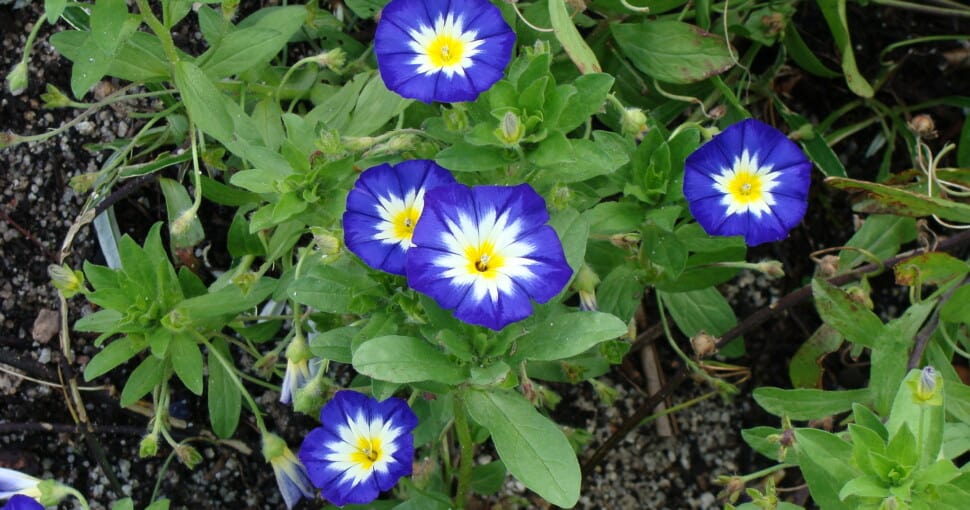Morning glories are fast-growing plants that butterflies and hummingbirds cannot resist. Ancient people used morning glory to convert latex into rubber. The plants have a hallucinogenic effect that Aztec priests used to enter trances, although ingesting morning glory can cause gastrointestinal complications and increased heart rate.
Morning glories belong to the Convolvulaceae family, and the largest genus is Ipomoea, although there are another nine groups. There are over one thousand species of this flowering plant.
It is thought that morning glories originated in China, but there is evidence of early civilizations in North And South America using morning glory seeds for medicinal and religious purposes.
Related: Are Morning Glories Poisonous?
Morning glory plants have unusual heart-shaped leaves, which make them popular with gardeners worldwide. The bright green, hairy leaves show prominent veins and are easily identifiable.
They are most popular and widely known for their distinctive trumpet-shaped flowers. The flowers can be blue, purple, pink, magenta, or striped with a white throat. The flowers occur singly or in clusters along the length of the plant, creating a spectacle of bright color in the garden.
The largest morning glory is the moonflower. It is a white cultivar with six-inch flowers that bloom at night.
Morning glories are hardy plants that grow in temperate and tropical zones. They do not survive extended frost, but their seeds spread during fall, allowing new plants to grow again in summer.
Morning glory grows as a creeping climber, ground cover, shrub, or tree. The creeping type is the most well-known. Morning glory is fast-growing and can quickly overcome other plants making it an alien invasive plant in some countries. For this reason, gardeners may want to find a replacement plant.
1. Sweet Potato
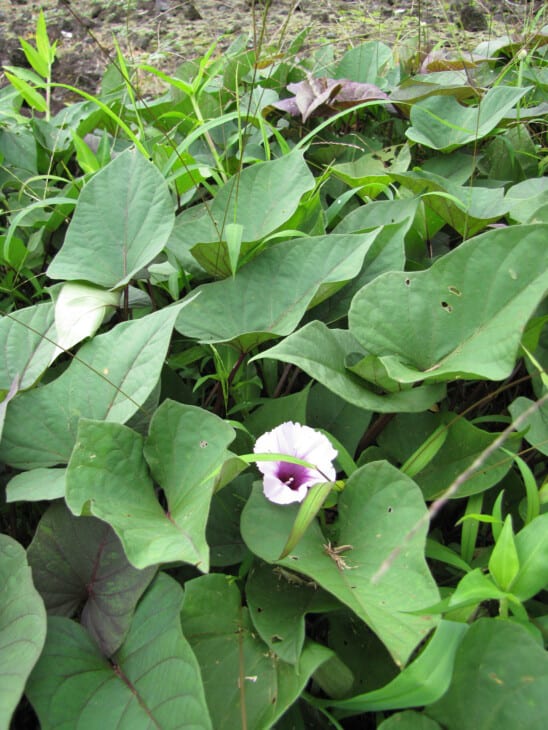
Sweet potatoes, like morning glory, belong to the Convolvulaceae family. Their botanical name is Ipomoea batatas. They are native to tropical regions of North and South America. The large tuberous roots have a sweet flavor and are eaten as a vegetable. In North America, sweet potatoes are also known as yams.
Sweet potatoes are grown throughout the world as a food source. Some sweet potato cultivars are ornamental and do not produce edible tubers.
Sweet potato grows as a herbaceous perennial creeper or vine. In climates with cold frosty winters, sweet potato is grown as an annual. It does not survive frosts.
The leaves vary in shape according to the cultivars. They may be heart, kidney, or egg-shaped. The leaf margin may be smooth or serrated. The leaves may be simple or lobed, varying from one to five inches.
Most sweet potato leaves are green, but some may be dark reddish purple. They are attractive plants and can be used for ornamental purposes. Some gardeners plant sweet potatoes as a summer garden feature and harvest the tubers in fall. Sweet potato plants are suitable for climbing a trellis, growing in a pot, or foliage in a flower bed.
Like morning glory, sweet potatoes produce trumpet-shaped flowers, which are usually lilac or darker lavender.
2. Petunias
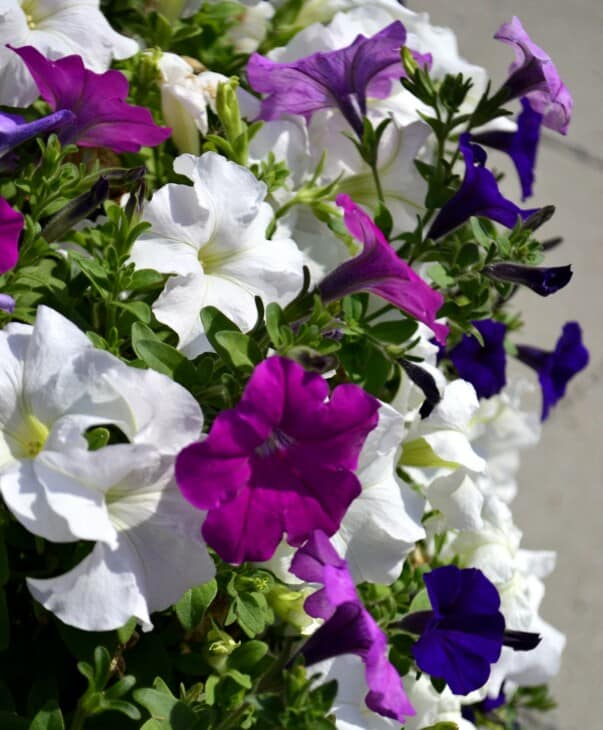
Petunias are from the Solanaceae plant family, which includes tomatoes, cape gooseberries, and tobacco. The twenty species of petunia are popular with gardeners worldwide. They originate in South America, but their hardiness has allowed them to survive in many different climates.
Petunias are perennial in warm climates, but in regions with icy winters, they do not survive and are grown as annuals. The twenty petunia species have been used to propagate many hybrids, allowing gardeners a wide choice of color and size.
Petunia flowers have a similar shape to morning glory and come in a range of colors. They can be a bright, solid color, polka-dotted (Night Sky variety), or even black such as the Black Velvet variety. Gardeners are spoiled for choice when it comes to choosing petunia colors.
Petunia varieties are grouped into four divisions.
Grandiflora petunias are some of the oldest varieties. The plant grows to a height of eight to twelve inches, and the flowers are four to five inches long. The big flowers are sensitive to downpours and windy weather, which can damage them. Once damaged, the flowers die and must be removed to allow new blooms to appear.
Multiflora petunias are slightly smaller, with flowers that survive the elements better than grandiflora petunias. They are known for producing masses of flowers. Hybrids created from grandiflora and multiflora petunias are called floribundas.
Millifloras are the smallest petunias in plant and flower size. Some people prefer the milliflora petunias for containers and window boxes.
Spreading petunias grow almost like creepers. They are useful for filling in large gaps in garden beds, covering them with swathes of vibrant color.
Related: Are Petunias Toxic?
3. Nasturtiums
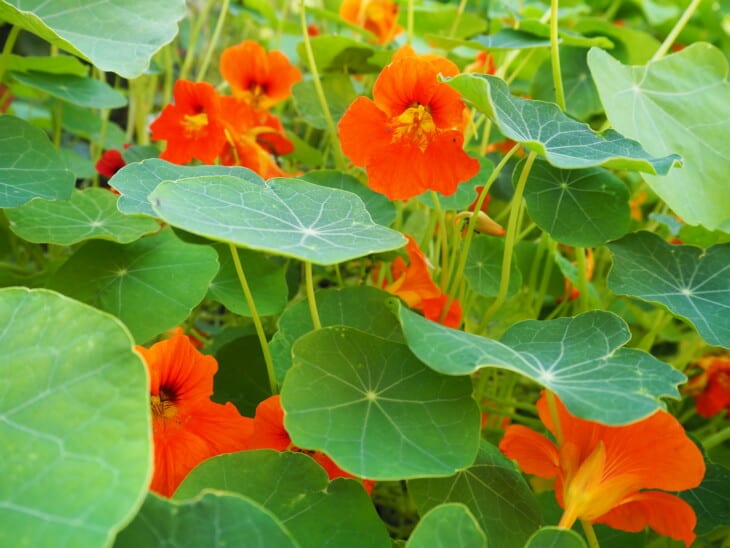
Nasturtiums have the tongue-twisting botanical name Tropaeolum and are part of the Tropaeolaceae family. The name nasturtium means to twist or tweak a nose. This rather unusual name arose from their peppery taste, which makes the nose itch.
Nasturtiums originated in Peru, Chile, and other South American countries. They have been selectively bred to create new types so that there are now approximately eighty species of nasturtium.
Nasturtiums grow as scrambling creepers that spread or climb or as small bushes. They are hardy plants that do not require rich soil or abundant water. If the soil is too rich, the foliage will flourish, but there will be few flowers. The minimal care required to grow nasturtiums makes them popular with gardeners looking for an alternative to morning glories.
Nasturtiums have distinctive rounded leaves. A light spot marks the site where the leaf stem joins the leaf. The veins radiate from the leaf stem junction and are clearly seen on the upper surface of the leaf.
Nasturtium flowers have five petals and come in yellow, red, orange, cream, and stripes. The flowers often have a dark center adding to the color variation. Nasturtium flowers, leaves, and seed pods are edible.
Nasturtiums do well in poor, well-drained soil in full sunlight. Regular watering will allow the plants to grow and flower optimally, but it is critical not to overwater them. Too little water can result in the nasturtiums becoming heat stressed.
4. Hardy Gloxinia
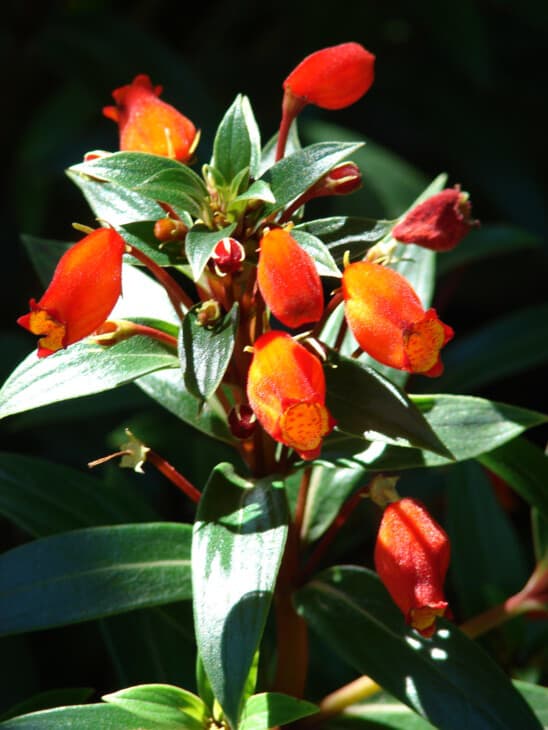
Hardy Gloxinias come from the genus Incarvillea and the family Bignoniaceae. They originated in the regions from Central Asia to the Himalayas and China. Hardy gloxinias are sometimes called flowering ferns.
Hardy Gloxinias are herbaceous perennials that grow from bulbs. They grow in clusters in partial shade or full sun. The foliage is green and resembles a fern, with each leaf about six inches long.
The flowers are usually pink and one to three inches long. They are trumpet-shaped, similar to morning glory flowers. Hardy Gloxinia flowers grow at the end of stiff flower stems. There are usually several flowers clustered on the stem.
5. Datura
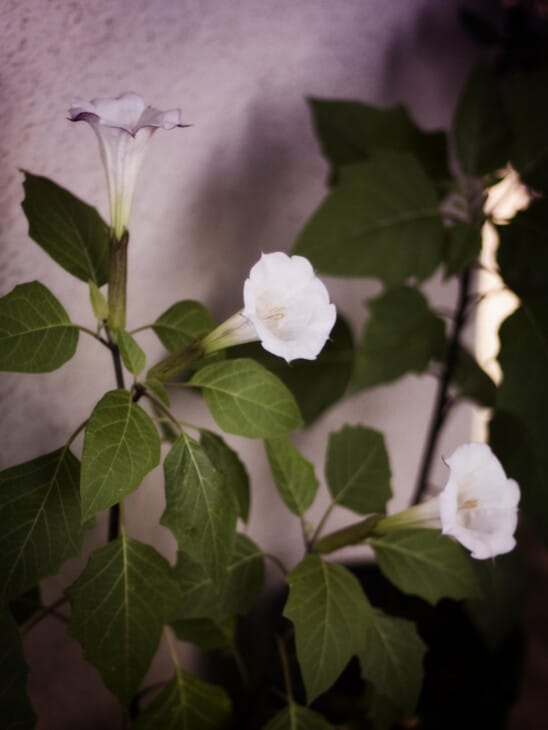
Daturas are from the Solanaceae plant family and are highly poisonous. They have several common names, the devil’s trumpet, thornapples, hell’s bells, and jimson weeds. The flowers and seeds depress respiratory and cardiac function and cause delirium, hallucinations, psychosis, fever, and anticholinergic syndrome, which can result in death.
Datura can be annuals or perennials, depending on the species and climate. They grow as bushes or small shrubs with a maximum height of six feet. The leaves are deeply lobed and vary in color from blackish-green to bright green.
Datura produces trumpet-shaped flowers, like morning glory, which can be white, pink, purple, or yellow. Once the flower wilts, a spined seed pod develops. The pod dries and splits open, allowing the seed to be dispersed by the wind.
Datura is regarded as a weed in many countries. They are problematic in fields where livestock graze as they are poisonous to animals and people.

